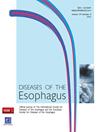黏膜阻抗作为胃食管反流病的诊断工具:临床医生的最新进展
IF 2.3
3区 医学
Q3 GASTROENTEROLOGY & HEPATOLOGY
引用次数: 0
摘要
粘膜阻抗是食管粘膜完整性的标志,也是评估食管功能和病理的一种新技术。本文重点介绍了它在胃食管反流病(GERD)、巴雷特食管和嗜酸性粒细胞食管炎方面的发展和临床应用。我们对描述粘膜阻抗在临床实践中的发展和应用的主要出版物进行了叙述性综述。低平均夜间基线阻抗(MNBI)已被证明是抗反流治疗反应的独立预测指标。MNBI 比食管远端酸暴露时间更能预测药物反应性烧心。与 MNBI 正常的患者相比,采用传统方法诊断胃食管反流病证据不明确但 MNBI 较低的患者在开始 PPI 治疗后症状有所改善。胃底折叠术后人群中也出现了类似的趋势。使用粘膜阻抗评估嗜酸性粒细胞食管炎的强大临床实用性已被反复证明,但在巴雷特食管中的应用方向却很少。作者总结道,粘膜阻抗在胃食管反流病的评估和诊断中具有潜在的临床实用性,尤其是在常规检查结果不明确的情况下。本文章由计算机程序翻译,如有差异,请以英文原文为准。
Mucosal impedance as a diagnostic tool for gastroesophageal reflux disease: an update for clinicians
Mucosal impedance is a marker of esophageal mucosal integrity and a novel technique for assessing esophageal function and pathology. This article highlights its development and clinical application for gastroesophageal reflux disease (GERD), Barrett’s esophagus, and eosinophilic esophagitis. A narrative review of key publications describing the development and use of mucosal impedance in clinical practice was conducted. A low mean nocturnal baseline impedance (MNBI) has been shown to be an independent predictor of response to anti-reflux therapy. MNBI predicts medication-responsive heartburn better than distal esophageal acid exposure time. Patients with equivocal evidence of GERD using conventional methods, with a low MNBI, had an improvement in symptoms following the initiation of PPI therapy compared to those with a normal MNBI. A similar trend was seen in a post fundoplication cohort. Strong clinical utility for the use of mucosal impedance in assessing eosinophilic esophagitis has been repeatedly demonstrated; however, there is minimal direction for application in Barrett’s esophagus. The authors conclude that mucosal impedance has potential clinical utility for the assessment and diagnosis of GERD, particularly when conventional investigations have yielded equivocal results.
求助全文
通过发布文献求助,成功后即可免费获取论文全文。
去求助
来源期刊

Diseases of the Esophagus
医学-胃肠肝病学
CiteScore
5.30
自引率
7.70%
发文量
568
审稿时长
6 months
期刊介绍:
Diseases of the Esophagus covers all aspects of the esophagus - etiology, investigation and diagnosis, and both medical and surgical treatment.
 求助内容:
求助内容: 应助结果提醒方式:
应助结果提醒方式:


